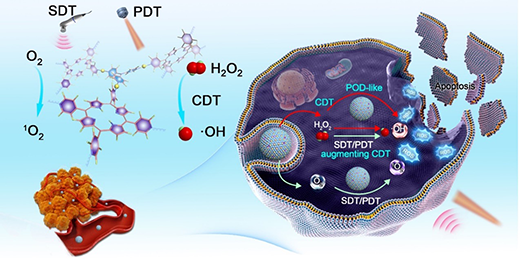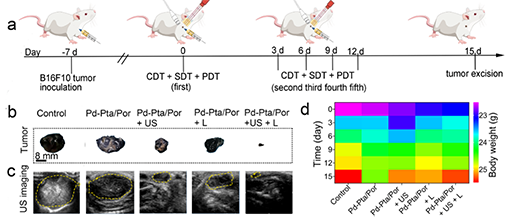| Oct 29, 2021 | |
Engineering of Pd-single-atom coordinated biocatalysts for chem-/sono-/photo-trimodal tumor therapies |
|
| (Nanowerk Spotlight) The diversity, complexity, and heterogeneity of malignant tumor seriously undermine the efficiency of mono-modal treatment. Recently, multi-modal therapeutics with enhanced antitumor efficiencies have attracted increasing attention. However, designing a nanotherapeutic platform with uniform morphology in nanoscale that integrates with efficient chem-/sono-/photo-trimodal tumor therapies is still a great challenge. | |
| “At present, semiconductor materials (e.g., TiO2) and conjugated organic structure (e.g., porphyrin) are the main materials that can be utilized to integrate CDT, SDT, and PDT in one nanoplatform,” says Prof. Chong Cheng, a full professor and a low-dimensional nanomaterials specialist at the College of Polymer Science and Engineering, State Key Laboratory of Polymer Materials Engineering in Sichuan University (China). | |
| However, the CDT efficiency of TiO2-based semiconductor materials is relatively low. And many reported porphyrin-metal coordination structures based on the carboxyl groups don’t present a strong π-conjugated system, the π-d delocalization effect of electrons is low, the conductivity is not sufficient, and the chemical stability is also poor, which may eventually lead to low biocatalytic activity and insufficient energy conversion efficiency for SDT and PDT when compared with the metal-N coordination structure. What’s more, the currently synthesized porphyrin-based metal-N coordination structure usually exhibits bulk materials with a micrometer scale. | |
| To overcome the difficulties on designing a nanotherapeutic platform with uniform morphology in nanoscale that integrates with efficient chem-/sono-/photo-trimodal tumor therapies, in a recent publication in Advanced Materials ("Pd-Single-Atom Coordinated Biocatalysts for Chem-/Sono-/Photo-Trimodal Tumor Therapies"), for the first time, Prof. Li Qiu at West China Hospital of Sichuan University and Prof. Chong Cheng at College of Polymer Science and Engineering, State Key Laboratory of Polymer Materials Engineering in Sichuan University, precisely designed a Pd single-atom coordinated polymers-based biocatalyst (Pd-Pta/Por) for achieving chem-/sono-/photo-trimodal dynamic tumor therapies. | |
 |
|
| Figure 1. Schematic illustration of Pd-single-atom coordinated biocatalysts for chem-/sono-/photo-trimodal tumor therapies. (Image provided by the researchers) (click on image to enlarge) | |
| The study verified that the Pd-Pta/Por biocatalyst consists of atomic Pd-N coordination active sites and owns efficient catalytic yield of reactive oxygen species for highly synergistic antitumor therapies, which takes an essential step toward developing ROS-related therapeutic and biological applications. | |
| “We have found that the biocatalyst consists of atomic Pd-N coordination networks with a Pd-N2-Cl2 catalytic center. The characterization of peroxidase-like catalytic activities displays that the Pd-Pta/Por can generate abundant •OH radicals for chemodynamic therapies. | |
| The ultrasound irradiation or laser excitation can significantly boost the catalytic production of 1O2 by the porphyrin-based sono/photo-sensitizers to achieve combined sono-/photo-dynamic therapies. The superior catalytic production of •OH is further verified by density functional theory calculation. | |
| Finally, the corresponding in vitro and in vivo experiments have demonstrated their synergistically chem-/sono-/photo-trimodal antitumor efficacies,” says the Prof. Chong Cheng. | |
 |
|
| Figure 2. Antitumor therapeutic effects of Pd-single-atom coordinated biocatalysts. (Image provided by the researchers) (click on image to enlarge) | |
| “Our study provides a new promising single-atom coordinated polymeric networks with highly efficient biocatalytic sites and synergistic trimodal therapeutic effects, which may inspire many new findings in ROS-related biological applications across broad therapeutics and biomedical fields,” says the Fangxue Du, the first author of this paper. | |
| Source: Provided as a Nanowerk exclusive by Prof. Dr. Chong Cheng, College of Polymer Science and Engineering, State Key Laboratory of Polymer Materials Engineering at Sichuan University | |
|
Become a Spotlight guest author! Join our large and growing group of guest contributors. Have you just published a scientific paper or have other exciting developments to share with the nanotechnology community? Here is how to publish on nanowerk.com. |
|
